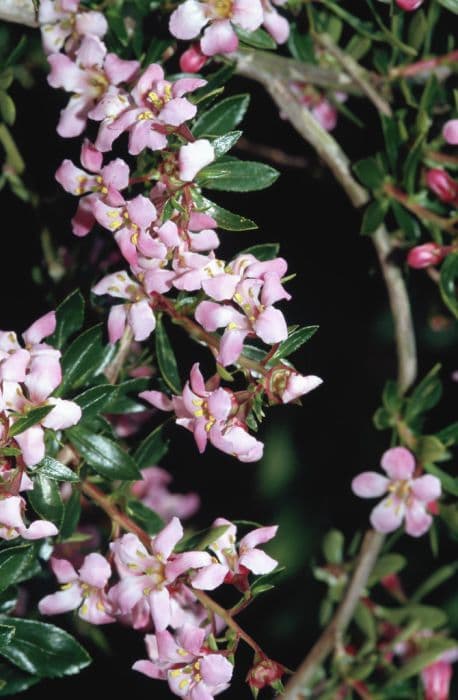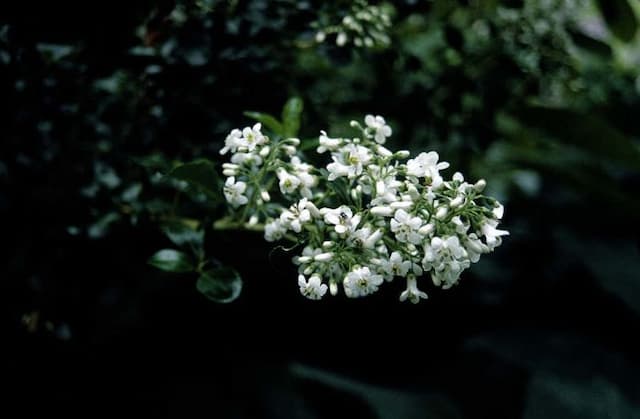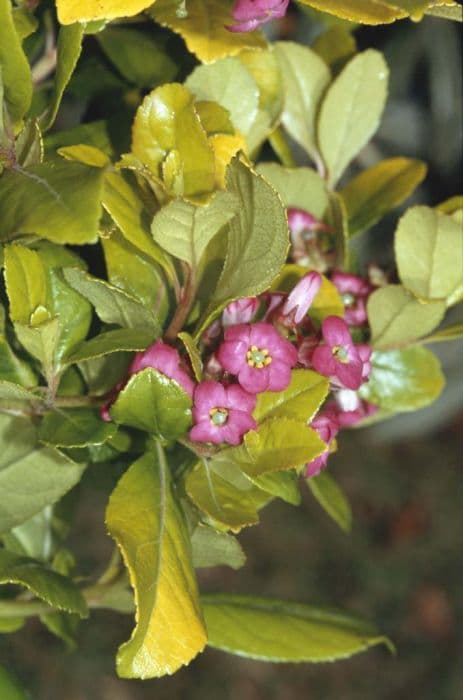Donard Radiance Escallonia Escallonia 'Donard Radiance'

ABOUT
Escallonia 'Donard Radiance' is a lush, evergreen shrub that boasts a dense and bushy habit. Its leaves are small, glossy, and dark green, providing a solid backdrop for the floral display. These leaves are also slightly toothed at the edges, giving them a textured appearance. The plant comes alive with a profusion of flowers, typically during the summer months. The blossoms are trumpet-shaped and arranged in clusters. They are a vibrant pink color, which stands out strikingly against the dark foliage. The pink flowers often attract various pollinators, adding movement and life to the plant's appearance. Moreover, the plant may take on a slightly arching form with its branches, which contributes to its overall ornamental appeal.
About this plant
 Names
NamesFamily
Escalloniaceae.
Synonyms
Donard Radiance Escallonia, Pink Escallonia.
Common names
Escallonia 'Donard Radiance'
 Toxicity
ToxicityTo humans
Escallonia is generally considered not toxic to humans. There are no well-documented cases or specific reports of toxicity from Escallonia 'Donard Radiance' to humans. This means that if ingested, it is unlikely to cause any significant or serious symptoms of poisoning. However, it's always prudent to avoid eating plants that are not known to be safe for consumption, and to keep in mind that individuals may have varying sensitivities or allergic reactions to plants.
To pets
Escallonia is typically not known to be toxic to pets. There are no specific reports of toxicity from Escallonia 'Donard Radiance' to domestic animals. Therefore, if a pet ingests this plant, it is unlikely to experience significant or serious symptoms of poisoning. Nonetheless, as pets can have different reactions to plants than humans do, and individual sensitivities can vary, it is still wise to monitor your pet's health and consult with a veterinarian if any unusual behavior or symptoms occur after ingestion.
 Characteristics
CharacteristicsLife cycle
Perennials
Foliage type
Evergreen
Color of leaves
Green
Flower color
Pink
Height
3-5 feet (0.91-1.52 meters)
Spread
3-5 feet (0.91-1.52 meters)
Plant type
Shrub
Hardiness zones
6-9
Native area
South America
Benefits
 General Benefits
General Benefits- Attractive Flowers: Produces pink blooms that add color and visual interest to gardens.
- Evergreen Foliage: Maintains its green leaves throughout the year, providing constant foliage.
- Wildlife Friendly: Attracts a variety of insects, including bees and butterflies, supporting biodiversity.
- Low Maintenance: Easy to care for, requiring minimal pruning and general garden care.
- Drought Tolerant: Once established, it can tolerate periods of low water, which is beneficial in drier climates or during water restrictions.
- Versatile Landscaping: Can be used for hedging, borders, or as a stand-alone specimen plant.
- Wind and Salt Tolerance: Suitable for coastal gardens where it can withstand harsh conditions.
- Fast Growing: Rapid growth rate allows for quick establishment and filling in garden spaces.
 Medical Properties
Medical PropertiesThis plant is not used for medical purposes.
 Air-purifying Qualities
Air-purifying QualitiesThis plant is not specifically known for air purifying qualities.
 Other Uses
Other Uses- Windbreaks: Escallonia 'Donard Radiance', with its dense growth habit, can be used to form windbreaks that protect more delicate plants or outdoor seating areas.
- Hedging for Coastal Areas: Because of its tolerance to salt spray, this plant is ideal for creating hedges in coastal gardens.
- Topiary: The robust nature of Escallonia 'Donard Radiance' allows it to be pruned and shaped into topiary forms, providing an artistic element to the garden.
- Natural Fencing: Its dense bushy nature can be utilized to create a natural fencing barrier, which can be used to delineate property lines or garden areas.
- Erosion Control: The extensive root system of this shrub can help stabilize slopes and areas prone to erosion.
- Foundation Plantings: Escallonia 'Donard Radiance' can be planted along building foundations to cover unsightly features or to provide a stable backdrop for seasonal flowers.
- Attracting Wildlife: The flowers are attractive to bees and butterflies, adding to the biodiversity of the garden ecosystem.
- Background Planting: Its size and foliage make it suitable for planting behind flower beds to create a lush green background for other plants.
- Privacy Screening: When planted in a row, Escallonia 'Donard Radiance' can offer privacy to patios and garden spaces.
- Container Gardening: Smaller specimens can be grown in containers for patios or balconies, offering flexibility in garden design.
Interesting Facts
 Feng Shui
Feng ShuiThe Escallonia is not used in Feng Shui practice.
 Zodiac Sign Compitability
Zodiac Sign CompitabilityThe Escallonia is not used in astrology practice.
 Plant Symbolism
Plant Symbolism- Resilience: The Escallonia 'Donard Radiance', being an evergreen shrub that withstands various climates, symbolizes the ability to endure and thrive in different conditions.
- Protection: Because Escallonia shrubs often form dense thickets, they can symbolize shelter and protection against external forces.
- Beauty: With its bright pink flowers, Escallonia 'Donard Radiance' is often associated with beauty and aesthetics, celebrating nature's visual gifts.
 Water
WaterEscallonia 'Donard Radiance', commonly known as Escallonia, should be watered deeply and thoroughly to encourage a strong root system. During the growing season, water the plant once a week, supplying about 1 to 1.5 gallons of water each time, depending on the size of the plant and the weather conditions. Cut back on watering during the winter months when the plant is not actively growing, ensuring the soil doesn't dry out completely. If the Escallonia is planted in well-draining soil, make sure that the water is penetrating several inches into the ground to reach the root zone. Overwatering can be detrimental to the plant's health, so allow the soil to dry out slightly between watering sessions.
 Light
LightEscallonia 'Donard Radiance' prefers a spot that receives full sun to part shade. To thrive, it should get at least six hours of direct sunlight daily but can tolerate some light shade, especially in the hottest part of the day. An ideal spot would be one that is sunny in the morning with some afternoon shade to protect it from intense, scorching heat.
 Temperature
TemperatureEscallonia 'Donard Radiance' thrives in a range of temperature conditions but prefers mild to warm climates. It can withstand temperatures as low as 10 to 15 degrees Fahrenheit for short periods but grows best when temperatures are consistently between 50 and 75 degrees Fahrenheit. Protect the plant from extreme cold by providing mulch or shelter if temperatures approach its minimum tolerance.
 Pruning
PruningEscallonia 'Donard Radiance' should be pruned to maintain shape and encourage bushy growth. The best time to prune is in late winter or early spring, just before new growth begins. Remove any dead or damaged wood and thin out overcrowded branches to allow light and air to reach the center of the plant. It’s also beneficial to lightly trim the plant after flowering to promote new blooms.
 Cleaning
CleaningAs needed
 Soil
SoilEscallonia requires well-draining soil with a pH range of 5.5 to 7.0. A mix of garden soil, peat, and perlite in equal parts works well to maintain moisture without becoming waterlogged.
 Repotting
RepottingEscallonia should be repotted every 2 to 3 years, or when the plant outgrows its current pot, to refresh the soil and allow for continued growth.
 Humidity & Misting
Humidity & MistingEscallonia, commonly known as 'Donard Radiance', thrives in moderate humidity levels but is quite adaptable to different humidity conditions as long as proper soil moisture is maintained.
 Suitable locations
Suitable locationsIndoor
Place in bright light, protect from scorching sun.
Outdoor
Sunny spot, shelter from strong winds.
Hardiness zone
7-9 USDA
 Life cycle
Life cycleEscallonia 'Donard Radiance', also known as Escallonia, begins its life cycle when its seeds, often produced after flowering, germinate in favorable conditions of warmth and moisture. Seedlings emerge and develop into young plants, establishing a root system and foliage during their growth stage. As it enters the vegetative stage, the plant matures, becoming bushier with glossy, evergreen leaves. Upon reaching maturity, it enters the flowering stage, usually in early to mid-summer, showcasing clusters of pink flowers that attract pollinators and subsequently facilitate cross-pollination. After pollination, the plant develops fruits that carry seeds, completing the reproductive stage of its life cycle. The Escallonia plant is perennial, allowing it to go through multiple flowering and seed-setting phases throughout its lifespan.
 Propogation
PropogationPropogation time
Spring-Early Summer
Escallonia 'Donard Radiance', commonly known as Escallonia, can be propagated most effectively with semi-hardwood cuttings. This process is typically done in late summer. To propagate, one selects healthy, semi-hardened shoots from the current year's growth and trims a cutting of about 4 to 6 inches (approximately 10 to 15 centimeters) in length, just below a leaf node. The cutting's lower leaves are removed, and the base is dipped into a rooting hormone to encourage root growth. The prepared cutting is then placed in a pot filled with a mixture of peat and perlite or a similar well-draining rooting medium. The pot is kept at a consistent moisture level and in a warm environment with indirect light until roots have developed, which can take several weeks. Once rooted, the cuttings can be transplanted to individual pots or directly into the garden.

![Escallonia [Golden Carpet]](/_next/image?url=https%3A%2F%2Fplants-admin.emdemapps.com%2Fimages%2Fplants%2F%2Fimages%2F604b59284be41.png&w=640&q=75)


![Escallonia [Pink Elle]](/_next/image?url=https%3A%2F%2Fplants-admin.emdemapps.com%2Fimages%2Fplants%2F%2Fimages%2F604b630962bc2.png&w=640&q=75)




